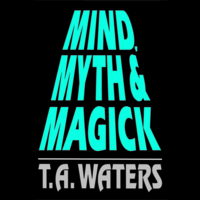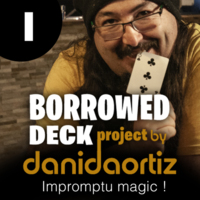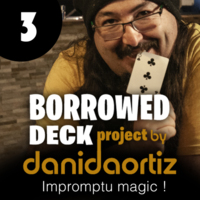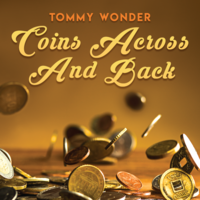Coins Across and Back by Tommy Wonder presented by Dan Harlan (Instant Download)
A full-length coin routine, a masterclass in misdirection. One of Tommy Wonder's signature effects, presented by the brilliant Dan Harlan. START LEARNING INSTANTLY.
Tommy Wonder was an incredible performer, well-known for his smooth sleight-of-hand, masterful misdirection, and devious devices. And now, a modern master of magical creativity shares his favorite Tommy Wonder creations with you as Dan Harlan presents "The Best of the Books of Wonder." Lesson 2 is Tommy’s brilliant Coins Across and Back. This deceptive coin routine is expertly taught by Dan Harlan who takes it off the page and puts it in your hands.
This clever routine delights audiences with precocious coins jumping back-and-forth, penetrating through your hand, vanishing and re-appearing in an unexpected place. Each phase more inexplicable than the previous. And the surprise ending is one of the most beautiful moments of magic ever conceived! In this lesson, Harlan has replaced the old suspicious prop while retaining all the incredible magic. You’ll learn to master every move, as the sleights involved are not knuckle-busters. Plus, you’ll learn the all-important timing and misdirection that makes this routine as much fun to perform as it is to watch! Once you see the reactions you can get, you’ll know you’ve found your favorite coin routine.
Coins Across and Back includes a full routine that you’ll learn all of the sleights for as well as a presentation that makes this routine a real crowd-pleaser. Lesson two takes the brilliance of Tommy Wonder’s magic and with Dan Harlan’s guidance puts this beautiful magic in your grasp. Subscribe to the entire series today and elevate your magic with the best of The Books of Wonder.
To see every trick in this series, visit The Best of The Books of Wonder presented by Dan Harlan.
ASK HERE
Featured Magic Tricks
Customer magic Acts that feature this trick
4 star 25%
3 star 25%
2 star 25%
1 star 0%

 Routine fine, not so much the sleights
Report this review
Routine fine, not so much the sleights
Report this review

 A good routine that needed more work
Report this review
A good routine that needed more work
Report this review

 A Versatile Real-World Routine
Report this review
A Versatile Real-World Routine
Report this review
These reviewers then say that the roughness of the performance means they doubt Dan’s choices in the routine, and therefore the routine is slapdash. I disagree. There are 3 main differences in Dan’s and Tommy’s routines:
1. Boston Box versus a drawstring bag
2. A hand-to-hand transfer
3. A Ross Bertram sequence
I believe all 3 of Dan’s choices are well-justified, and he explains them well.
Dan uses a drawstring bag instead of a Boston Box. A Boston Box is an odd apparatus, and it’s an expense. If you’re carrying everything in your pockets, it’s heavy. If you’re going to keep the arrangement of the coins in the Boston box, which tends to open up and spill, you will need to keep it in a purse or A DRAWSTRING BAG. The bag offers several advantages, including cost and lightness. But Dan explains what you need to customize a container for the routine, so Dan is giving you options.
Dan’s hand-to-hand transfer is motivated. Even Bill Malone, who has tremendous skills, uses a similar principle to make his pass invisible. Dan explains Tommy’s move, which you can do if you prefer, but keep in mind you’re not Tommy Wonder.
The Ross Bertram sequence is tough to do convincingly, and Dan points to laymen’s observations of its transparency. Again, do it if you want, but it’s unnecessary, and you probably aren’t as good as Ross Bertram.
Tommy Wonder created a genius routine in which the second phase repeats the first, but with a different method and a presentational twist. The challenge in any coins across is the ending. Usually, the last coin is anticlimactic. But Wonder devised a killer ending, and Dan brings down the house with it. The point is not to rate Dan like a gymnast doing a floor routine, but to look at the genuine reactions he gets.
Here we have a routine that uses regular coins, is self-contained in a single bag (or coin purse), instantly resets, and gets strong audience reactions. If you’re a restaurant worker, stroller, or have your own table at a venue, a routine like this is invaluable, a real worker.

 Ok
Report this review
Ok
Report this review

Act Builder beta

















































